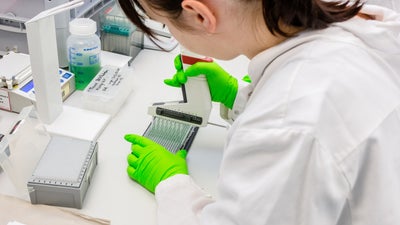DKMS Stem Cell Bank
To help patients even faster our DKMS Stem Cell Bank conserves two types of blood stem cells. Blood stem cells from umbilical cord blood bank donated after birth and surplus blood stem cells from donors who are already saving one live with their donation.
To help patients even faster our DKMS Stem Cell Bank conserves two types of blood stem cells. Blood stem cells from umbilical cord blood bank donated after birth and surplus blood stem cells from donors who are already saving one live with their donation. These might save a second sick person in the near future.

Many patients with blood cancer and other blood disorders cannot survive without a life-saving stem cell donation. Only one third of patients find a matching donor in their own family while the majority depend on an unrelated donor, who is a genetic match with the patient. For many patients, the search for a donor is the beginning of a race against time. The faster a suitable donor is found, the better the chances of survival for the patient. “Freezing” or “cryopreservation”, as it is called in jargon, of surplus blood stem cells fosters fast availability of the much needed and live-saving donation.
And this is not all. Our DKMS Stem Cell bank also acts as an umbilical cord blood unit: because stem cells from cord blood can be collected in an easy and safe way for mother and child.
Saving two lives with one donation
Often the amount of blood stem cells taken from a blood stem cell donor exceeds the needs of the patient who requires them for the transplantation. With the donors' consent, these surplus cells can now be frozen rather than disposed of. For that, we have equipped our DKMS Stem Cell Bank in Dresden, Germany, with a state-of-the-art cleanroom laboratory. This way, we can make the blood stem cells available to blood cancer patients worldwide for a possible further life-saving transplantation.
For donations to our DKMS Stem Cell Bank, we are only asking donors who are already requested for a peripheral stem cell collection for a specific patient. For the donor, the removal of additional cells, apart from a slightly longer apheresis period, does not mean any additional effort and no additional health risk. A standard stem cell donation will be carried out in which the permissible blood volume will be processed. The cells collected in this way will be donated for the patient in need of the transplant and the surplus cells will be stored in the DKMS Stem Cell Bank. They may soon enable another sick person to receive a life-saving stem cell transplantation.
We will fully inform our donors who are eligible for a stored donation in the DKMS Stem Cell Bank in advance and ask for an additional declaration of consent.
Umbilical Cord Blood: Helping without risk
During pregnancy the umbilical cord is absolutely vital for the development of the baby. When the newborn sees the light of day, is healthy and happy, the umbilical cord has fulfilled its task. However, the blood in the umbilical cord is not superfluous, but can do great things - because it contains valuable stem cells that can save lives. If they are collected and conserved immediately after cutting the cord, the great miracle may soon happen and a patient will get a new chance at life!
Fast availability
For patients in urgent need of a transplant, umbilical cord blood as well as cryopreserved blood stem cells are available much faster. The donation of the stem cells for a specific patient already took place Also, in cases where a patient needs a second stem cell donation and stem cells have been stored, they are available without the donor having to donate a second time. The blood stem cells from our DKMS Stem Cell Bank are available with a probability of almost 100% within three days. This is essential as in some diseases, carrying out the transplantation quickly improves the success of the transplant.


